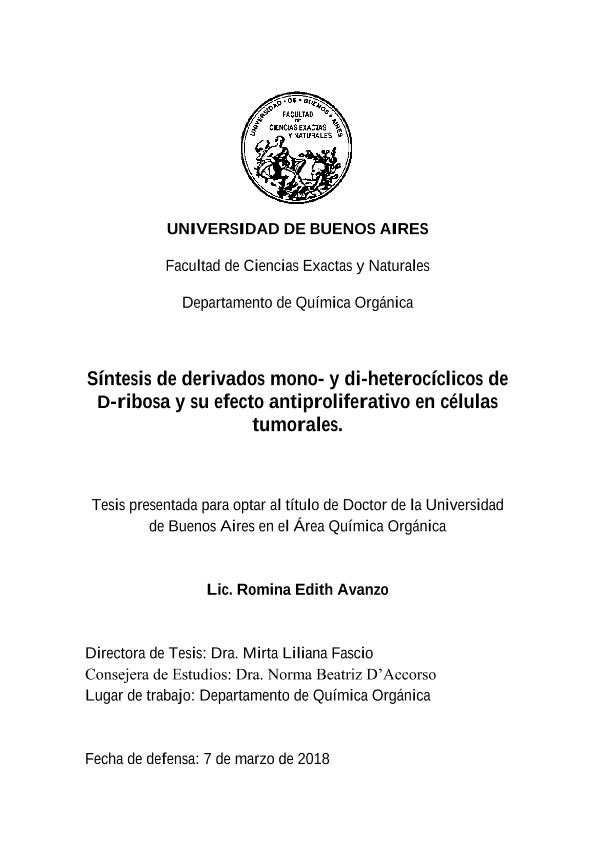Tesis doctoral
El desarrollo de nuevos principios activos para el tratamiento de enfermedades tales como el cáncer es un tema de interés continuo debido a la agresividad y/o a la rápida resistencia a fármacos que presentan estas enfermedades. El uso de un heterociclo no natural como base nitrogenada es una de las aproximaciones usadas para obtener novedosos análogos de nucleósidos. Además, cabe destacar que la presencia de más de un anillo heterocíclico puede potenciar la actividad de los compuestos independientemente de su acción terapéutica. En el presente trabajo de tesis se sintetizaron y caracterizaron compuestos mono- y di-heterocíclicos derivados de D-ribofuranosa, donde la nucleobase consistió en heterociclos de cinco miembros, unidos por un espaciador. Para evaluar la influencia del tipo y cantidad de heteroátomos se sintetizaron 1,2,3-triazoles, 1,2,4-oxadiazoles, isoxazoles e isoxazolinas utilizando tanto reacciones de cicloadición 1,3-dipolares como de condensación intramolecular. A partir de los derivados mono-heterocíclicos, fue posible obtener derivados di-heterocíclicos por funcionalización del carbono terminal del hidrato de carbono con anillos tales como 1,2,4-triazol, 1,3,4-tiadiazol o 1,2,4-triazolil-3-tiona. Con el objetivo de analizar la influencia de los grupos protectores en las posiciones dos y tres de la D-ribosa se sintetizaron compuestos con grupos isopropilidén y ciclopentilidén. Estos últimos presentaron la mayor actividad antiproliferativa. Los compuestos di-heterocíclicos así como también intermediarios y precursores fueron evaluados como agentes antitumorales contra diferentes líneas celulares humanas. El compuesto más activo presentó una CI50 de 4,5 micromolar contra la línea celular de cáncer de colon WiDr. The synthesis of small molecules with antitumor activity remains the focus of attraction of many research groups because of the ability to develop resistance to traditional therapies and/or the aggressiveness that these diseases present. The use of unnatural heterocycles as unconventional nucleobases is one of the typical strategies to obtain nucleoside analogues. In addition, it should be noted that the presence of more than one heterocyclic ring may enhance the activity of the compounds irrespective of their therapeutic action. For these reasons, the aim of the present work was to synthesize and characterize Dribofuranoside heterocyclic derivatives in which the nucleobase consists of fivemembered heterocyclic rings, connected by a linker. Reactions of 1,3-dipolar cycloadditions and intramolecular condensations were carried out to synthetize 1,2,3- triazoles, 1,2,4-oxadiazoles, isoxazoles and isoxazolines to evaluate the influences of the type, quantity, and distributions of heteroatoms in the heterocyclic unit. It was possible to obtain di-heterocyclic derivatives from mono-heterocycles by functionalization of carbon in five position of the carbohydrate moiety with 1,2,4-triazoles, 1,3,4-thiadiazoles or 1,2,4-triazolyl-3-thiones. With the objective of comparing the influences of different protective groups on the activity, isopropylidene and cyclopentilidene D-ribose derivatives were synthesized. The presence of the cyclopentilidene group was relevant for the antiproliferative activity of the compounds. The di-heterocyclic compounds as well as some precursors and intermediates were evaluated as antitumor agents against different human cancer cell lines. The most active compound exhibited an IC50 value of 4.5 M against colon cancer cell line WiDr.
Síntesis de derivados mono- y di-heterocíclicos de D-ribosa y su efecto antiproliferativo en células tumorales
Título:
Synthesis of mono- y di-heterocyclic D-ribose derivatives and their antiproliferative effect against cancer cell lines
Avanzo, Romina Edith

Director:
Fascio, Mirta Liliana

Consejero de estudios:
D'accorso, Norma Beatriz

Fecha de publicación:
07/03/2018
Idioma:
Español
Clasificación temática:
Resumen
Archivos asociados
Licencia
Identificadores
Colecciones
Tesis(UMYMFOR)
Tesis de UNID.MICROANAL.Y MET.FISICOS EN QUIM.ORG.(I)
Tesis de UNID.MICROANAL.Y MET.FISICOS EN QUIM.ORG.(I)
Citación
Avanzo, Romina Edith; Fascio, Mirta Liliana; D'accorso, Norma Beatriz; Síntesis de derivados mono- y di-heterocíclicos de D-ribosa y su efecto antiproliferativo en células tumorales; 7-3-2018
Compartir



